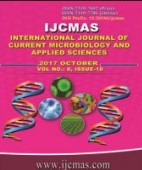


 National Academy of Agricultural Sciences (NAAS)
National Academy of Agricultural Sciences (NAAS)

|
PRINT ISSN : 2319-7692
Online ISSN : 2319-7706 Issues : 12 per year Publisher : Excellent Publishers Email : editorijcmas@gmail.com / submit@ijcmas.com Editor-in-chief: Dr.M.Prakash Index Copernicus ICV 2018: 95.39 NAAS RATING 2020: 5.38 |
The study aims to elucidate the impact of organic inputs on strength and structural stability of aggregates in a sandy loam soil of Indo-Gangetic Plain Zone of India. Tensile strength, friability and water stability of aggregates, and the carbon contents in bulk soil and in large macro (>2 mm), small macro (0.25-2 mm), micro (0.053-0.25 mm) and silt+ clay size (<0.053) The aggregate were evaluated in soils with different sources and amounts of organic C inputs as partial substitution of N fertilizer. Addition of organic substrates significantly improved soil organic C contents, but the type and source of input had different impacts. Tensile strength of aggregates decreased and friability increased through organic inputs, with a maximum effect under rice residue-farmyard manure and wheat residue substitution.The aggregate strength and density were lower with organic substitution (p < 0.05) while water retention by aggregates at field capacity was 2–4% higher with organic inputs. Macro-aggregates (>0.25 mm) constituted 58–92% of water stable aggregates and varied significantly among treatments and soil depths. Organic material incorporation improved soil aggregation and structural stability and resulted in higher C content in macro-aggregates. Higher macro-aggregates in the crop residue- and farmyard manure-treated soils resulted in a higher aggregate mean weight diameter, which also had higher soil organic C contents. The bulk soil organic C had a strong relation with the mean weight diameter of aggregates, but the soil organic c content in all aggregate fractions was not necessarily effective for aggregate stability. The soil organic C content in large macro-aggregates (2-8mm) had a significant positive effect on aggregate stability, although a reverse effect was observed for aggregates<0.25 mm. Partial substitution of nitrogen by organic substrates improved aggregate properties and the soil organic C content in bulk soil and aggregate fractions, although the relative effect varied with the source and amount of the organic inputs.
 |
 |
 |
 |
 |